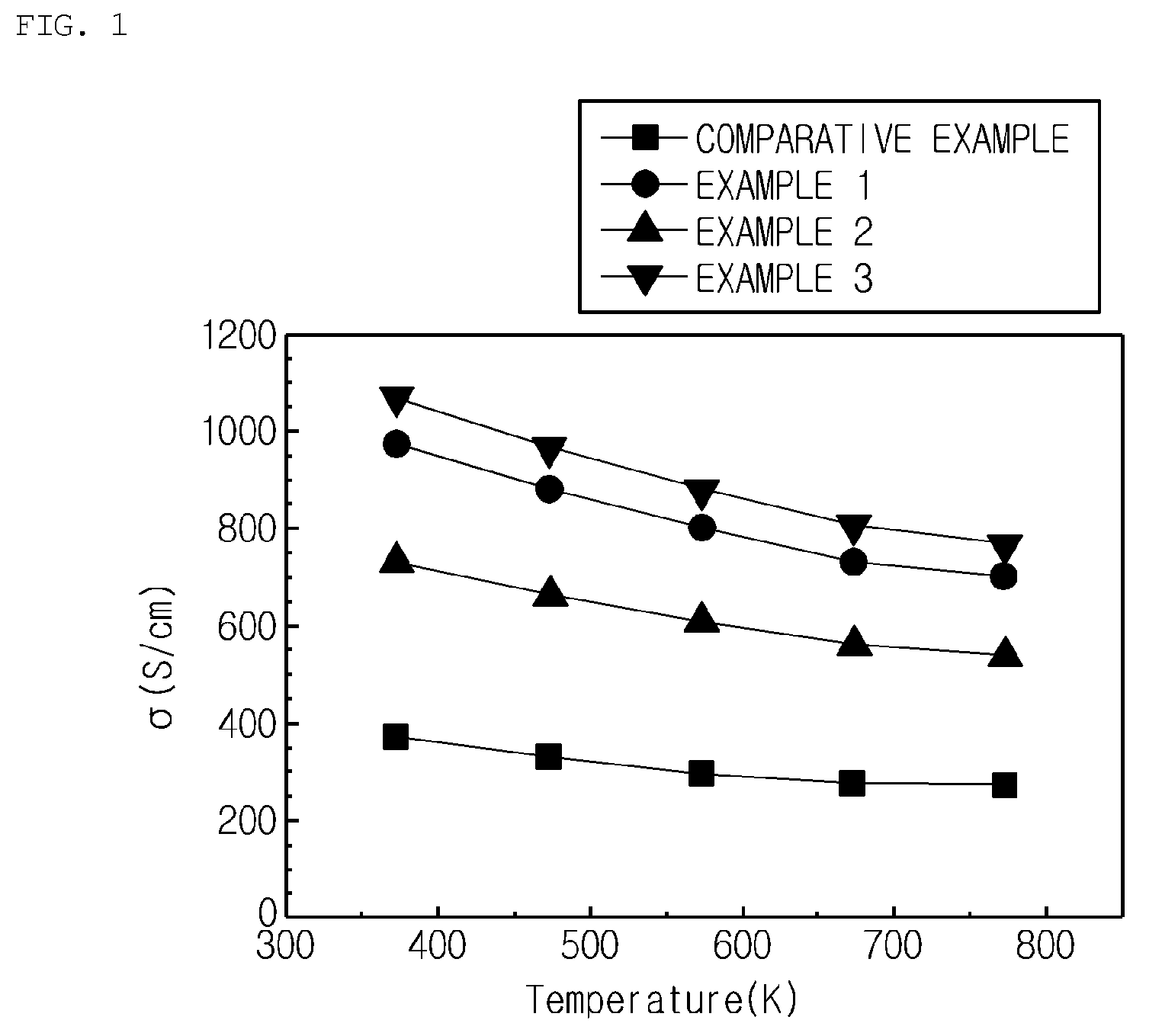Compound semiconductors and their application
a technology of compound semiconductors and semiconductors, applied in the direction of non-metal conductors, physical/chemical process catalysts, metal/metal-oxide/metal-hydroxide catalysts, etc., can solve the problems that many conventional compound semiconductors fail to meet all of these conditions at once, and achieve good thermoelectric conversion performance
- Summary
- Abstract
- Description
- Claims
- Application Information
AI Technical Summary
Benefits of technology
Problems solved by technology
Method used
Image
Examples
example 1
[0069]In, Co, Zn, Sb and Te were prepared as reagents, and were mixed by using mortar to make a mixture having a composition of In0.25Zn0.1Co4Sb11Te in a pellet form.
[0070]The materials mixed as above were put into a silica tube and vacuum-sealed and then heated at 650° C. for 36 hours. The time for raising the temperature to 650° C. was 1 hour and 30 minutes, and In0.25Zn0.1Co4Sb11Te powder was obtained.
[0071]A part of the composed materials prepared above was formed into a cylinder having a diameter of 4 mm and a length of 15 mm, and another part was formed into a disk having a diameter of 10 mm and a thickness of 1 mm. After that, a pressure of 200 MPa was applied thereto by using a CIP (Cold Isostatic Pressing). Subsequently, the obtained result was put into a quartz tube and vacuum-sintered for 12 hours.
[0072]In regard to the sintered disk, thermal conductivity (κ) of the material prepared above was measured by using TC-7000 (Ulvac-Rico, Inc). The measurement result is shown in...
example 2
[0074]In, Co, Zn, Cd, Sb and Te were prepared as reagents, and were mixed by using mortar to make a mixture having compositions of In0.25Zn0.1Cd0.1Co4Sb11Te in a pellet form.
[0075]The materials mixed as above were put in a silica tube and vacuumsealed, and then were heated at 650° C. for 36 hours. The time for raising the temperature to 650° C. was 1 hour and 30 minutes, and In0.25Zn0.1Cd0.1Co4Sb11Te powder was obtained.
[0076]A part of the material prepared above was formed into a cylinder having a diameter of 4 mm and a length of 15 mm, and another part was formed into a disk having a diameter of 10 mm and a thickness of 1 mm. After that, a pressure of 200 MPa was applied thereto by using a CIP. Subsequently, the obtained result was put into a quartz tube and vacuum-sintered for 12 hours.
[0077]In regard to the sintered disk, thermal conductivity (κ) of the material prepared above was measured by using TC-7000 (Ulvac-Rico, Inc). The measurement result is shown in FIG. 2 as Example 2...
example 3
[0079]In, Co, Zn, Cd, Sb, Ni and Te were prepared as reagents, and were mixed by using mortar to make a mixture having compositions of In0.25Zn0.1Cd0.1Co3.98Ni0.02Sb11Te in a pellet form.
[0080]The materials mixed as above were put into a silica tube and vacuum-sealed and then heated at 650° C. for 36 hours. Here, the temperature rising time was 1 hour and 30 minutes, and In0.25Zn0.1Cd0.1Co3.98Ni0.02Sb11Te powder was obtained.
[0081]A part of the material prepared above was formed into a cylinder having a diameter of 4 mm and a length of 15 mm, and another part was formed into a disk having a diameter of 10 mm and a thickness of 1 mm. After that, a pressure of 200 MPa was applied thereto by using a CIP. Subsequently, the obtained result was put into a quartz tube and vacuum-sintered for 12 hours.
[0082]In regard to the sintered disk, thermal conductivity (κ) of the material prepared above was measured by using TC-7000 (Ulvac-Rico, Inc). The measurement result is shown in FIG. 2 as Exam...
PUM
| Property | Measurement | Unit |
|---|---|---|
| temperature | aaaaa | aaaaa |
| temperature | aaaaa | aaaaa |
| temperature | aaaaa | aaaaa |
Abstract
Description
Claims
Application Information
 Login to View More
Login to View More - R&D
- Intellectual Property
- Life Sciences
- Materials
- Tech Scout
- Unparalleled Data Quality
- Higher Quality Content
- 60% Fewer Hallucinations
Browse by: Latest US Patents, China's latest patents, Technical Efficacy Thesaurus, Application Domain, Technology Topic, Popular Technical Reports.
© 2025 PatSnap. All rights reserved.Legal|Privacy policy|Modern Slavery Act Transparency Statement|Sitemap|About US| Contact US: help@patsnap.com



